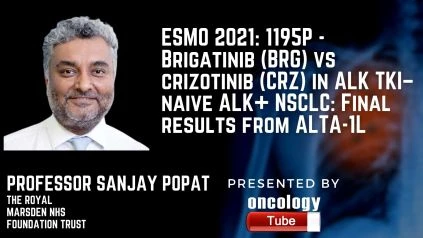Professor Sanjay Popat, Consultant Medical Oncologist BSc MBBS FRCP Ph.D., The Royal Marsden NHS Foundation Trust speaks about the ESMO 2021 Abstract – 1195P – Brigatinib (BRG) vs crizotinib (CRZ) in ALK TKI–naive ALK+ NSCLC: Final results from ALTA-1L.
Link to Abstract:
https://cslide.ctimeetingtech.com/esmo2021/attendee/confcal_4/presentation/list?q=ALTA&r=pt%7E53
Abstract:
Background:
BRG BIRC-assessed PFS was superior to CRZ in two planned interim assessments of ALTA-1L (NCT02737501). The ALTA-1L results are presented in their final form.
Methods:
ALK TKI–naive advanced ALK+ NSCLC patients (pts) were enrolled and categorized by baseline (BL), brain metastases (BM), and previous treatment (CT). A previous CT scan for advanced NSCLC and asymptomatic BM was permitted. BRG 180 mg qd (7-day lead-in at 90 mg) or CRZ 250 mg BID were given to patients in a 1:1 ratio. At the end of the study, participants in the CRZ arm were given BRG. PFS as evaluated by the BIRC is the primary outcome (RECIST v1.1). Confirmed iORR, iPFS by BIRC, OS, safety, and QoL were all secondary goals.
Results:
275 patients were randomized (BRG/CRZ, n=137/138); median age was 58/60 years; previous CT was 26%/27%; BL BM was 29%/30%. The median follow-up was 40.4/15.2 months (BRG/CRZ) as of 29 January 2021 (last patient contact), with 166 (73/93) PFS events. PFS HR calculated by the BIRC was 0.48 (95 percent CI: 0.35–0.66, log-rank P0.0001); BRG mPFS was 24.0 months (95 percent CI: 18.4–43.2) vs CRZ 11.1 months (95 percent CI: 9.1–13.0); 3-year PFS rate was (BRG/CRZ) 43 percent /19 percent. PFS HR was 0.43 (95 percent CI: 0.31–0.58, mPFS 30.8 versus 9.2 mo) as determined by the investigators. The mDoR (BIRC) value was 33/14 months. In both groups, the median OS was not attained (events BRG/CRZ: 41/51; HR: 0.81 [95 percent CI: 0.53–1.22]; log rank P=0.3311), and the 3-year OS was 71 percent /68 percent. OS HR was 0.43 (95 percent CI: 0.21–0.89; Table) in pts with BL BM and 1.16 (0.69–1.93) in pts without BL BM. The following are the most prevalent grade 3 TEAEs: BRG: elevated CPK (26%) and lipase (15%), as well as hypertension (14%); CRZ: raised ALT (10%), lipase (8%), and AST (8%). (7 percent ). Discontinuation owing to AE: 13.2 percent /8.8 percent; any grade ILD/pneumonitis (BRG/CRZ): 4.4 percent /2.2 percent. (BRG/CRZ) 26.7/8.3 mo; HR: 0.69 (95 percent CI: 0.49–0.98) was the median time to deterioration in pt-reported global health status/QoL.
Conclusions:
BRG exhibited long-term overall and intracranial effectiveness, with a constant and tolerable tolerability profile despite prolonged therapy, establishing BRG as a successful standard-of-care treatment in patients with treatment-naive ALK+ NSCLC.
Clinical trial identification
NCT02737501; Release date: 30 March 2016.

